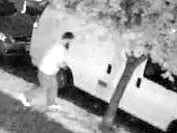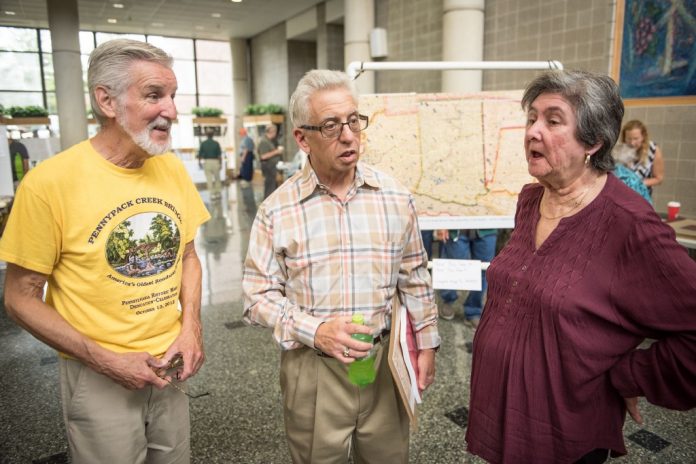Turning the pages of history: The Northeast Philadelphia History Fair took place on Saturday at Holy Family University. Old Northeast Philadelphia County, 1609–1854, originally written by a junior history class from Northeast High in 1968, was reprinted and featured at the event. One of the original editors of the book, Bob Lankin (center), is joined by Fred Moore and Elaine Schurr at the event.
High school kids must have had it pretty rough in the days before the Internet.
Just imagine: they had to go to an actual library to do a research project. They used index cards and pencils to take notes — after all, “cut and paste” meant using actual scissors and glue … and that would’ve been considered plagiarism anyway. If students wanted to illustrate their research, there was no Wikimedia at hand. They basically had to draw their own images.
And don’t forget all of that typing … on a typewriter, no less. Talk about typos.
In case you’ve forgotten about all of that, or perhaps are too young to have lived it, pick up a copy of Old Northeast Philadelphia County, 1609–1854, a newly reprinted volume examining the development of the Northeast from the time of the first European settlement to the consolidation of Philadelphia County. A junior history class from Northeast High School originally published the 202-page book almost a half-century ago.
The recently rediscovered reference work was one of two new local history books featured during the Northeast Philadelphia History Fair on Saturday at Holy Family University. The other, Tacony: Era of William H. Gatzmer and the Philadelphia & Trenton Rail Road by Charles McCloskey, sheds light on the oft-overlooked origins of Tacony prior to the Disston Saw Works and Disston Estate.
Bob Lankin, a 1969 Northeast High graduate, served as an original editor of Old Northeast and has been a key figure in its revival, along with Fred Moore of the Friends of Northeast Philadelphia History, the group that organized Saturday’s fair.
“It’s amazing to have done something that somebody is actually interested in forty years after we wrote it,” Lankin told the Northeast Times during the fair.
Elaine Schurr, who typed the original manuscript and whose brother, Michael Raitman, is credited as a co-author, joined Lankin at a booth, discussing the book with curious fair attendees. Lankin doesn’t expect that the notoriety will grow much more from here.
“Today is it,” he said. “I’ll put it onto Facebook and then it’ll go back into history.”
When originally printed on the high school’s in-house Pied Typer Press in January 1969, about 200 spiral-bound copies were distributed among participating students, local libraries and historical societies. No money changed hands, as the school had plenty of resources at the time. Many of the copies were never seen publicly again. But one found its way into the private collection of one of the Northeast’s leading historians, the late Pat Worthington-Stopper, who donated her archives to the Friends group in 2013.
The impetus to reprint the book grew last spring after Moore and Lankin met at a local Rotary Club meeting, then Lankin attended a Northeast History Network meeting where he discussed his role in the project.
The Friends group used its own resources, including a Philadelphia Activities Fund grant, to underwrite the new edition, which features new forewords by both Moore and Lankin, 13 original chapters divided into two sections, 17 hand-drawn maps and 30 line sketches based on historical photographs. The index alone is 19 pages. The book also has extensive bibliographies after each section. To recapture some of its investment, the Friends group is selling copies for $20 each.
According to Lankin, the original book was an unintended byproduct of a class assignment. In the spring semester of his junior year, the administration at Northeast High changed the curriculum for teacher Cora Hurwitz’s history class. Instead of the standard American history, the class was assigned to study local history. The change was part of a school accreditation process, Lankin recalled.
There were about 30 students in the class. They split up into five groups, each with a different assignment. Lankin’s group studied the history of Lower Dublin and Delaware Townships, which were two of the geographical designations that pre-dated the 1854 Philadelphia consolidation. Other groups studied the other Northeast townships and boroughs, while another researched topics such as Native American presence, early Europeans, economic and social development, government and politics and factors in the county consolidation.
While using what now can be considered obsolete methods, the students were very much ahead of their time. They tried to find records about local slaves, but couldn’t find any.
“That was until we went to a dusty room in the city archives in City Hall and found tax records. They listed the land, livestock and slaves they had,” Lankin said.
The slaves were listed by numbers, but there were no names. Slave counts began to disappear around the time of the Revolution, leading the students to believe that the practice was ending in Pennsylvania at that time.
Class members also tried to research the history of the local Jewish community, but found no records. They concluded that Jews didn’t settle in the Northeast until later.
In general, the research was time-consuming and tedious, taking students to the Holmesburg Branch Library, the Frankford Historical Society, the Pennsylvania Historical Society, the Ryerss Mansion and other sites. Students gathered routinely at the research sites after school.
“The teacher was generous. She knew how hard we worked on it. She gave everybody an ‘A’ who got into it. It was the best grade I ever got in high school,” Lankin said.
Recognizing their commitment, Hurwitz also began to push the concept of a book, selecting the top essays for each topic and encouraging the others to proofread and edit the material.
“While we were writing it, she kept saying, ‘This is the kind of stuff people do in graduate school,’” Lankin said. “The problem was it took so much time. We were working every day after school and still couldn’t meet the deadlines, but she gave us more time.”
The work continued after the school year, throughout summer 1968 and into the fall, leading to the January release.
“We loved it. It was so much fun. We wanted to see it through,” Lankin said.
Contact [email protected] to purchase a copy of Old Northeast Philadelphia County, 1609–1854. The book will also be available at the Dec. 8 meeting of the Historical Society of Frankford, at 1507 Orthodox St., at 7:30 p.m. ••

Surveillance photo





